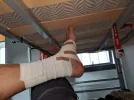mike g
New Member
I would have taken a bicycle. Not a tech 4k$ wonder of modern manufacturing but a nicely appointed $400 dollar Trek such as I have at home. No insignia bedecked, spandex tights hog the usb ports in the albergues, equipment laden miracle of modern efficiency for me. Just a nice bicycle. Why one would ask? Because the Del Norte is mainly pavement. More than a few that I met along the way complaining; in a nice way particularly those who had started in Irun "when is this going to be over''. I sustained an ankle injury three days before Baamonde and ended taking the train to Santiago via a Coruna from Baamonde. The continuous up and down coupled with the mostly pavement path was more than my 67 year old ankles could take. Were there any don't miss portions one could walk them and send their bicycles ahead, for about six bucks. I did my walking on the Frances in 2016 and am still warm in my heart from the experience. My focus this time had changed bit and I would have loved to do the side trips that a bicycle would have allowed. Remind yourself that the Del Norte is much hillier than the Frances and that much of it is on pavement. You can make plenty of friends just buy beer or snacks to share at the end of the day. Oh btw I'm walking the El Porto next year.




















